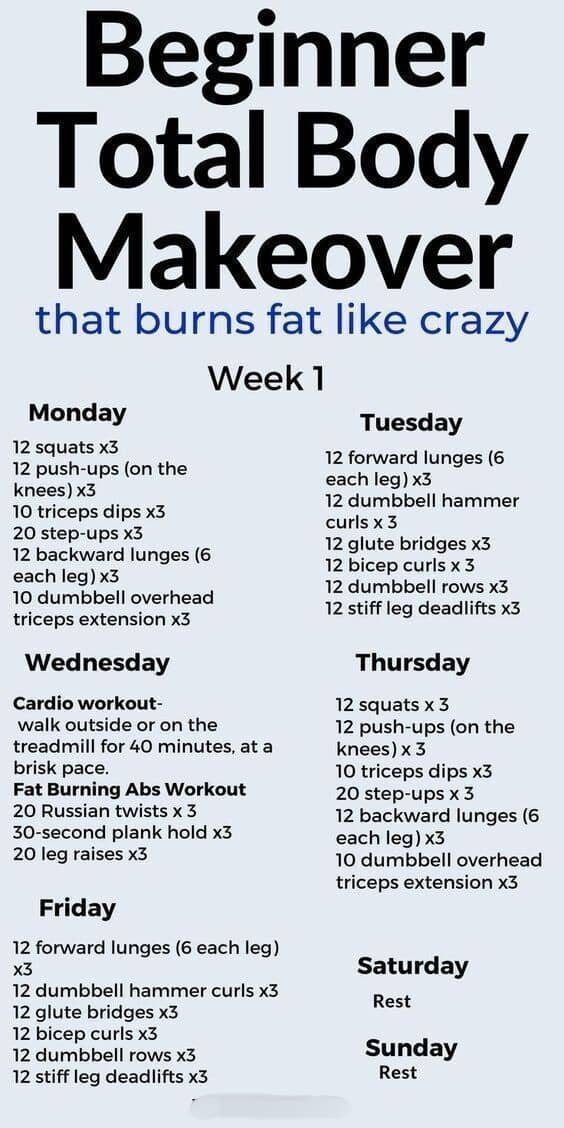Are you looking to jumpstart a fitness journey but don’t quite know where to begin? This Beginner Total Body Makeover plan is a perfect starting point. Designed to help you build strength, tone muscles, and burn fat, it focuses on foundational exercises that engage your whole body. Below, you’ll find a detailed breakdown of each day’s workout routine, tips on form, guidance for rest days, and additional strategies to help you optimize your results. Whether you are completely new to working out or returning after a break, this plan will give you the structure you need to stay motivated and see tangible progress.
Table of Contents
- Why a Beginner-Friendly Total Body Program?
- Safety First: Consult a Professional
- Weekly Workout Overview
- Detailed Daily Breakdown
- Proper Form Tips for Each Exercise
- Nutrition and Lifestyle Tips
- Progression and Next Steps
- Frequently Asked Questions
- Final Thoughts
Why a Beginner-Friendly Total Body Program?
Starting your fitness journey with a total body approach offers several benefits:
- Balanced Development: By targeting multiple muscle groups in the same routine, you ensure your entire body progresses in harmony, reducing the risk of imbalances and injuries.
- Fat-Burning: Exercises that engage large muscle groups—or several muscle groups at once—help you burn more calories and ultimately can contribute to weight loss.
- Time Efficiency: Total body workouts are ideal for those with busy schedules; you can see results with fewer sessions per week compared to splitting the body into isolated “muscle group” workouts.
- Motivation: Feeling your entire body getting stronger can be incredibly motivating. Achieving small wins across the board—such as improved push-ups or deeper lunges—keeps the momentum going.
By following this Beginner Total Body Makeover plan consistently, you can develop a strong foundation and pave the way for more advanced routines in the future.
Safety First: Consult a Professional
Before beginning any new exercise program—especially if you’re new to working out, have underlying health conditions, or are recovering from an injury—consult a healthcare professional. A doctor or certified trainer can help you:
- Identify any movement restrictions
- Recommend personalized modifications
- Ensure you have the right progression for your fitness level
Listening to your body is crucial. If you experience severe pain or discomfort while exercising, stop and consult a professional.
Weekly Workout Overview
Below is a snapshot of the Week 1 schedule for your Beginner Total Body Makeover. Each day has a specific focus, targeting various muscle groups and helping you burn fat efficiently.
- Monday: Lower body and arm strength (squats, push-ups, triceps dips, lunges, overhead extensions)
- Tuesday: Functional movements and upper/lower body combination (forward lunges, dumbbell hammer curls, glute bridges, bicep curls, rows, stiff leg deadlifts)
- Wednesday: Cardio + Core (brisk walking or treadmill plus abs exercises like Russian twists, plank holds, and leg raises)
- Thursday: Repeat Monday’s routine with slight variations (squats, push-ups, triceps dips, step-ups, backward lunges, overhead triceps extensions)
- Friday: Repeat Tuesday’s routine with slight variations (forward lunges, hammer curls, glute bridges, bicep curls, rows, stiff leg deadlifts)
- Saturday: Rest
- Sunday: Rest
This plan gives you five active days, which strike a balance between sufficient workout frequency and essential recovery time.
Detailed Daily Breakdown
Monday
- Squats – 12 reps x 3 sets
- Push-ups (on the knees) – 12 reps x 3 sets
- Triceps Dips – 10 reps x 3 sets
- Step-ups – 20 reps x 3 sets
- Backward Lunges (6 each leg) – 12 total reps x 3 sets
- Dumbbell Overhead Triceps Extensions – 10 reps x 3 sets
Focus on technique and go slow to feel each muscle engage. Keep rest periods between sets around 30–60 seconds for a moderate intensity that still allows recovery.
Tuesday
- Forward Lunges (6 each leg) – 12 total reps x 3 sets
- Dumbbell Hammer Curls – 12 reps x 3 sets
- Glute Bridges – 12 reps x 3 sets
- Bicep Curls – 12 reps x 3 sets
- Dumbbell Rows – 12 reps x 3 sets
- Stiff Leg Deadlifts – 12 reps x 3 sets
Today combines lower-body power (lunges, deadlifts, glute bridges) with upper-body strength (curls, rows). Pay extra attention to form when performing deadlifts, as correct posture is crucial for avoiding back strain.
Wednesday
Cardio Workout
- Walk outside or use a treadmill for 40 minutes at a brisk pace
Fat Burning Abs Workout
- Russian Twists – 20 reps x 3 sets
- Plank Hold – 30 seconds x 3 sets
- Leg Raises – 20 reps x 3 sets
The brisk 40-minute walk will help you burn calories, improve cardiovascular health, and warm up your body for the subsequent abs routine. A steady-state cardio session can also aid in active recovery. The abs workout targets your core muscles from multiple angles, contributing to overall stability and better posture.
Thursday
- Squats – 12 reps x 3 sets
- Push-ups (on the knees) – 12 reps x 3 sets
- Triceps Dips – 10 reps x 3 sets
- Step-ups – 20 reps x 3 sets
- Backward Lunges (6 each leg) – 12 total reps x 3 sets
- Dumbbell Overhead Triceps Extensions – 10 reps x 3 sets
This is a near-repeat of Monday’s routine, reinforcing the foundational movements. Focus on slightly improving form or increasing the weight if you feel comfortable. Pay attention to your breathing: inhale as you lower and exhale as you push or lift.
Friday
- Forward Lunges (6 each leg) – 12 total reps x 3 sets
- Dumbbell Hammer Curls – 12 reps x 3 sets
- Glute Bridges – 12 reps x 3 sets
- Bicep Curls – 12 reps x 3 sets
- Dumbbell Rows – 12 reps x 3 sets
- Stiff Leg Deadlifts – 12 reps x 3 sets
Just like Tuesday, you’ll build strength in both the upper and lower body. By Friday, you might notice you’re more comfortable with the movements. Consider small weight increases if you’ve mastered the form.
Saturday – Rest
Your body needs time to recover, rebuild muscle fibers, and restore energy. This is non-negotiable—rest days are where your body does most of its growth and repair. You can still do light activities such as gentle yoga or stretching if you wish to aid recovery, but stay away from intense training.
Sunday – Rest
Another day of complete rest helps reset your muscles and mind for the upcoming week. Use this time to evaluate your progress, plan healthy meals, or simply unwind with friends and family.
Proper Form Tips for Each Exercise
To get the most out of each movement and avoid injury, pay attention to these key form cues:
- Squats:
- Keep your chest up and gaze forward.
- Push your hips back like you’re sitting in a chair.
- Keep knees in line with toes—avoid letting them cave inward.
- Push-ups (on the knees):
- Place hands slightly wider than shoulder-width.
- Keep your core tight and spine neutral.
- Lower your chest to just above the ground, then push back up.
- Triceps Dips:
- Keep your hands on a stable surface behind you, fingers pointing forward.
- Bend at the elbows and keep them pointing backward, not flaring out.
- Engage your triceps to push yourself back up.
- Step-ups:
- Use a sturdy bench or step.
- Place your entire foot on the step for stability.
- Push through the heel as you step up, keeping your balance centered.
- Backward Lunges:
- Step back carefully, keeping the front foot planted.
- Lower hips until both knees are at about 90 degrees.
- Keep your torso upright—avoid leaning forward excessively.
- Dumbbell Overhead Triceps Extension:
- Hold a dumbbell (or two lighter dumbbells) behind your head.
- Keep your elbows close to your ears as you straighten arms overhead.
- Engage your core to avoid arching your back.
- Forward Lunges:
- Take a big step forward, bending both knees to about 90 degrees.
- Keep front knee aligned over ankle.
- Push off the front foot to return to the starting position.
- Dumbbell Hammer Curls:
- Keep your palms facing each other throughout the movement.
- Curl the weights up, focus on your biceps, and avoid swinging the arms.
- Keep your elbows close to your sides.
- Glute Bridges:
- Lie on your back, feet flat on the floor, knees bent.
- Drive through the heels to lift your hips.
- Squeeze your glutes at the top before lowering slowly.
- Bicep Curls:
- Stand tall, palms facing forward.
- Curl the weights up, keeping the elbows locked at your sides.
- Lower under control to avoid momentum.
- Dumbbell Rows:
- Hinge slightly at the hips with a neutral spine.
- Pull the dumbbells toward your ribcage, squeezing your shoulder blades together.
- Avoid hunching your back; keep the motion controlled.
- Stiff Leg Deadlifts:
- Keep feet hip-width apart and a slight bend in your knees.
- Hinge at the hips while keeping your back straight.
- Move the dumbbells down your thighs until you feel a stretch in your hamstrings, then return upright.
- Russian Twists:
- Sit on the floor with knees bent, heels on the ground.
- Lean back slightly for balance, and twist from the torso side to side.
- Exhale as you rotate to each side, engaging the obliques.
- Plank Hold:
- Keep your body in a straight line from head to heels.
- Engage your core and glutes.
- Avoid sagging hips or elevating the buttocks too high.
- Leg Raises:
- Lie on your back, hands under your hips for support if needed.
- Keep your lower back pressed into the floor as you lift and lower your legs.
- Move slowly to maintain control and maximize abdominal engagement.
Nutrition and Lifestyle Tips
While exercise is vital, nutrition and overall lifestyle habits also play a significant role in achieving a total body makeover. Consider these tips:
- Balanced Diet:
- Incorporate lean proteins (chicken, fish, tofu, beans), complex carbohydrates (whole grains, oats, quinoa), and healthy fats (avocados, nuts, seeds).
- Fill half your plate with vegetables for vitamins, minerals, and fiber.
- Stay Hydrated:
- Drink water consistently throughout the day.
- Proper hydration supports muscle function, aids digestion, and helps with overall recovery.
- Adequate Protein:
- Protein is essential for muscle repair and growth.
- Consider sources like eggs, low-fat dairy, protein shakes, or legumes if you have dietary restrictions.
- Calorie Control:
- For fat loss, aim for a moderate calorie deficit.
- Starvation diets are not sustainable and can lead to nutrient deficiencies and muscle loss.
- Healthy Sleep Habits:
- Aim for 7–9 hours of quality sleep.
- Rest is crucial for muscle recovery and hormone regulation.
- Stress Management:
- High stress can lead to elevated cortisol levels, which can hinder fat loss and muscle growth.
- Activities like meditation, light yoga, or journaling can help.
Progression and Next Steps
After you complete Week 1 (and potentially follow this same regimen for a few weeks), consider the following to keep seeing results:
- Increase Reps or Weight: Once 12 reps feel easy, try 15 or 20. Alternatively, gradually increase your dumbbell weight.
- Reduce Rest Time: Shortening the breaks between sets can increase intensity and caloric burn.
- Focus on Mind-Muscle Connection: Slow, controlled movements can yield better results than rushed reps.
- Experiment with New Exercises: After mastering these basics, you can incorporate variations like Bulgarian split squats, single-arm rows, or standard push-ups.
The key to progress is consistency. Celebrate every milestone—like adding an extra push-up or squatting a heavier weight. Small gains compound over time!
Frequently Asked Questions
- Can I do these exercises at home?
Absolutely! Most exercises only require a pair of dumbbells, a stable surface for dips or step-ups, and enough floor space for moves like planks or lunges. - How do I know if I’m ready for standard push-ups?
If you can comfortably do 12 push-ups on your knees with excellent form and a stable core, you can attempt a few standard push-ups. Transition gradually, perhaps doing half your sets on the knees and half in standard push-up form. - Is 40 minutes of walking enough for cardio?
For many beginners, 40 minutes of brisk walking is an excellent cardio session. If you feel you can handle more, you can increase speed, incline, or duration. Always prioritize good form and avoid pushing too hard too soon. - What if I don’t have dumbbells?
You can use water bottles, resistance bands, or even weighted household items as a substitute. Make sure the weight feels challenging but doesn’t compromise form. - When will I see results?
Individual results vary based on factors like diet, sleep, stress, and consistency. Many beginners notice increased stamina and better muscle tone within 4–6 weeks of consistent effort. - Can I skip rest days?
It’s generally not advisable. Rest days are crucial for muscle repair, hormone regulation, and overall recovery, which helps prevent injury and burnout.
Final Thoughts
Embarking on a fitness journey with this Beginner Total Body Makeover routine sets you on the path to better health, a leaner physique, and improved confidence. By targeting all major muscle groups, incorporating brisk cardio, and emphasizing core strength, you’re building a robust foundation for long-term success.
Stay consistent, listen to your body, and remember to celebrate your progress—no matter how small it might seem. Pair these workouts with a balanced diet, proper hydration, and sufficient rest. Over time, you’ll not only see a physical transformation but also enjoy enhanced energy levels, improved posture, and greater mental clarity.
Disclaimer: This article is for informational purposes only and does not replace professional medical advice. Before beginning any exercise program, consult a physician or certified fitness professional, especially if you have a pre-existing health condition.
By following this plan and sticking to healthy habits, you’ll be well on your way to achieving your fitness goals. Here’s to a healthier, stronger you—one workout at a time!










